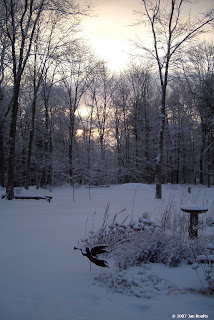 Photograph by Bates Littlehales
Photograph by Bates LittlehalesWhat do you call a group of sharp little mammals covered in a defense mechanism of 30,000 quills? You call them a prickle of porcupines! The quills are indeed the hallmark of these animals, known as the prickliest of rodents, though its Latin meaning is "quill pig." Controlled by muscles, the quills lift up in warning when a porcupine is threatened. Contrary to popular belief, a porcupine does not have the ability to throw its quills; they actually slap a victim with their tail in self-defense.
Last fall, I spotted two porcupines crossing my front yard – hmmm, does that make a prickle? They are quite comical to watch with their plodding gait, lifting one foot at a time, claws spread wide, gently testing the area in front of them. I have since learned that porcupines are extremely near-sighted, seeing only two to five feet in the distance, so they move with great caution. However, they do have a keen sense of smell, hearing, and taste. When the two heard me, they immediately went up the nearest tree, chattering and clacking their teeth, a warning for me to back away. The larger one was shaking and swaying on the limb, announcing his distress with low grunts and whines. Often times their high-pitched cry is mistaken for a bobcat or mountain lion. Porcupines are shy, so my presence was making them terribly stressed; and I was probably interrupting the rituals of their mating season. On my approach, one of them decided to produce his noxious odor to stop me in my tracks, while at the same time spraying urine from his perch at the top of the tree above the second porcupine. I presume the offender was the male, as research revealed that they perform a very vocal mating dance and spray urine over the head of the female.
Female porcupines give birth to a single baby, seven months after mating. Quills are soft on the newborns, called “porcupettes,” and they harden within several hours after birth. Within only a couple of days, the baby begins to forage for food; mother and baby will stay together for about six months. Would this photo, then be a “prickle of porcupettes”?

Photo courtesy of AP Photo/Fritz Reiss
In the winter, porcupines sleep in a den, sometimes for two to three days at a time, coming out only to feed, then return to shelter. Solitary for most of the year, porcupines will share a den for the communal heat, which consists of earth or rock caves and hollow logs. They are mainly nocturnal and do not hibernate; in all other seasons, they roost and feed in trees. One would believe porcupines to be accomplished tree climbers – they are not. According to the Massachusetts Department of Fish and Game, “thirty percent of the animals examined in one study showed evidence of healed fractures indicating that they had fallen out of trees.”
Porcupines are not territorial, and their home range may be as large as two hundred acres. Strict vegetarians, they will munch their way through a large variety of plants, shrubs, and trees. During the winter months, they will feed on pine needles and tree bark; summertime brings a menu of grasses, leaves, dandelions, clover and other wildflowers. Porcupines can swim, so pondweeds and water lilies are also part of the summer diet.
Regarded as one of the most important mammalian forestry pests, the common porcupine often causes death of timber and ornamental trees by girdling the bark of the trunk or stripping all of the bark above the snowline. Their feeding habits also contribute to orchard and crop damage, as well as injury to domestic animals and the transmitting of diseases. While generally thought of as a nuisance, some people consider the porcupine edible. Native Americans have been using the quills for centuries to make boxes, jewelry, and other artwork.
Porcupines have a great love of salt, which is why you see them loitering around the edges of highways that are salted during the winter. Individual animals will gnaw woodwork, furniture, tools, saddles, and other objects that have received salt deposits from human perspiration. Their search for sodium can bring about the destruction of objects such as handrails, steps, and doorways.
In our region, the predators of the porcupine include humans, fishers, martens, coyotes, and bald eagles. Fishers tend to be the most successful predators due to their technique of flipping the porcupine on its back, exposing the unprotected belly. A nasty, vicious animal, the Fisher will kill for the sport even when not hungry as was evident at a neighbors when all his chickens were killed, most of the decapitated birds left in the yard. The Massachusetts Fisheries and Wildlife website states, “The fisher (Martes pennanti), is relatively common in many areas despite the fact that it was once eliminated from Massachusetts. Considered by many to be a strictly wilderness species, the fisher is now appearing in more populated areas.”
Fisher Photo by John Wasserman
The North American porcupine, Erethizon dorsatum, is one of the world's largest rodents; it is a medium-sized animal, related to mice, rats, and beaver. An adult animal is about twenty inches long, not counting the tail, and weighs from ten to thirty pounds. Research shows fossils of porcupine ancestors that date back to the Oligocene epoch, about thirty million years ago, and that they originated in South America. The porcupine might not be one of the great beauties of the natural world, but they have proven themselves masters of survival. Act I, Scene V from Hamlet, reminds us that all creatures have a place in art, as well as science:
I could a tale unfold whose lightest word
Would harrow up thy soul…
…And each particular hair to stand on end,
Like quills upon the fretful porpentine {sic}”















